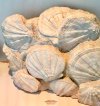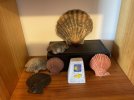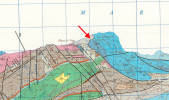JustOneGuy
Active Member
- Time of past OR future Camino
- Aug 2024: GR130, Apr 25: Camino Primitivo?
As I keep dreaming about the time when I will be able to start a real Camino  , I was thinking about the origin of the shell represented in the Compostela. I mean the so called concha (the shell), not the symbol.
, I was thinking about the origin of the shell represented in the Compostela. I mean the so called concha (the shell), not the symbol.
As everyone knows, I guess, it is a shell of the Pectinidae family, which features between 250 and 900 species (the subject is controversial, though.) If, however, one also includes fossil species, then one reaches about 7000 different species. The Pectinidae have had a rather troubled history: very common in the Mesozoic (the age of reptiles), they became much rarer at the end of that period, in the Cretaceous, before spreading again in the Tertiary (66-2.6 million years ago).
These shells can be found in all the world's oceans... and in many dishes served at the table. Fortunately for us and unfortunately for them.
Pectinidae features several quite unique properties. By studying the subject a bit, I ‘discovered’ for example that scallops have dozens, sometimes hundreds (depending on the species) iridescent eyes. Also, that they can move in both directions, but while forwards they zig-zag, backwards they simply go straight.
But... no, they don't have legs. Or at least, we should not discuss the topic in public:
My interest in the subject arose when I found several Pectinidae embedded in some strata of a asturian beach. In fact, my avatar is from a photo taken there.
It looks very much like some of the beaches in the South West of the UK. It is interesting to note that Pectinae originated in the Triassic (about 200 million years ago), whereas some of the north coast of Spain is much older: some rocks date back as far as the Precambrian (4.6 billion years ago).
I added a few photos of those Pectinidae's fossils I hope someone enjoys:
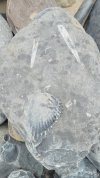
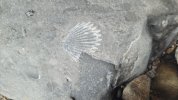
The photos were taken at the right end of Playa de Vega, near Ribadesella (many Trilobite fossils were found during the excavation of a nearby highway tunnel):
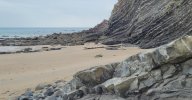
NOTES:
I hope I got everything right, but I will be grateful to anyone more knowlegeable who will correct me or will add more interesting information on the topic.
Last but not least, I encourage people to look for them if interested, but please, take a photo and leave the specimen there for others to enjoy. Thanks!
As everyone knows, I guess, it is a shell of the Pectinidae family, which features between 250 and 900 species (the subject is controversial, though.) If, however, one also includes fossil species, then one reaches about 7000 different species. The Pectinidae have had a rather troubled history: very common in the Mesozoic (the age of reptiles), they became much rarer at the end of that period, in the Cretaceous, before spreading again in the Tertiary (66-2.6 million years ago).
These shells can be found in all the world's oceans... and in many dishes served at the table. Fortunately for us and unfortunately for them.
Pectinidae features several quite unique properties. By studying the subject a bit, I ‘discovered’ for example that scallops have dozens, sometimes hundreds (depending on the species) iridescent eyes. Also, that they can move in both directions, but while forwards they zig-zag, backwards they simply go straight.
But... no, they don't have legs. Or at least, we should not discuss the topic in public:

My interest in the subject arose when I found several Pectinidae embedded in some strata of a asturian beach. In fact, my avatar is from a photo taken there.
It looks very much like some of the beaches in the South West of the UK. It is interesting to note that Pectinae originated in the Triassic (about 200 million years ago), whereas some of the north coast of Spain is much older: some rocks date back as far as the Precambrian (4.6 billion years ago).
I added a few photos of those Pectinidae's fossils I hope someone enjoys:


The photos were taken at the right end of Playa de Vega, near Ribadesella (many Trilobite fossils were found during the excavation of a nearby highway tunnel):

NOTES:
I hope I got everything right, but I will be grateful to anyone more knowlegeable who will correct me or will add more interesting information on the topic.
Last but not least, I encourage people to look for them if interested, but please, take a photo and leave the specimen there for others to enjoy. Thanks!
Last edited:






